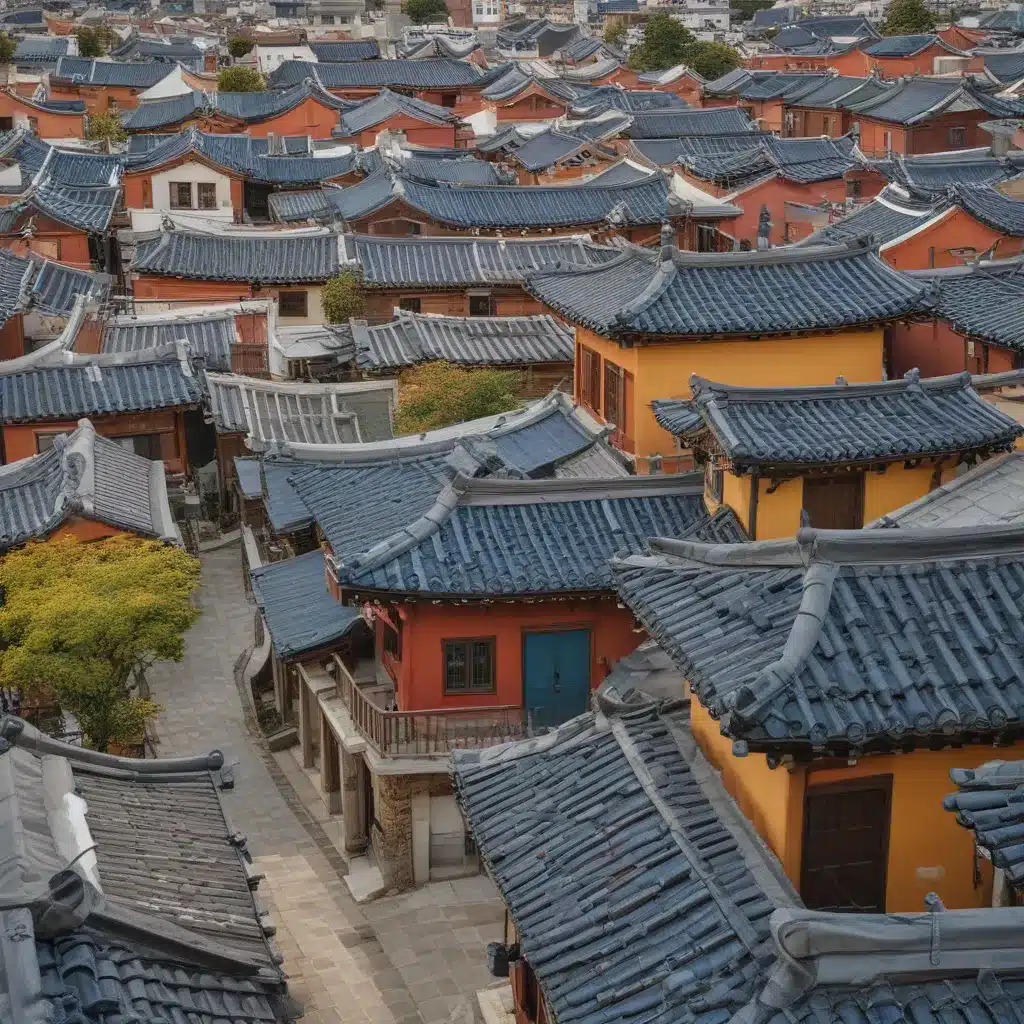
Stepping into the Joseon Dynasty
As I stood at the grand Gwanghwamun Gate, gazing up at the ornate, sweeping rooftops of Gyeongbokgung Palace, I couldn’t help but feel a sense of wonder and excitement. The majestic architecture before me seemed to transport me back in time, to the days of the Joseon Dynasty. This was my first glimpse into the rich cultural heritage of Seoul, and I couldn’t wait to explore further.
My journey had begun earlier that day, when I set out to discover the historic heart of the city. I started at Gyeongbokgung Palace, the largest and most impressive of the Joseon palaces. As I wandered through the grand courtyards and intricate buildings, I was captivated by the vibrant colors and intricate details that adorned the roofs and facades. The experience of donning a traditional hanbok and exploring the palace grounds only heightened my sense of immersion in the past.
Discovering Bukchon Hanok Village
But the real gem of my Seoul adventure was yet to come. After exploring Gyeongbokgung, I set out on the short walk towards Bukchon Hanok Village, a neighborhood that has managed to preserve the traditional Korean architecture of the Joseon era.
As I entered the winding, hilly streets of Bukchon, I was immediately captivated by the charming hanok houses that lined the way. These traditional Korean homes, with their distinctive tiled roofs and intricate wooden facades, seemed to embody the very essence of Korean culture.
I slowly meandered through the narrow alleyways, admiring the vibrant hues of the roofs that ranged from deep reds and blues to earthy browns and greens. The juxtaposition of these colorful rooftops against the backdrop of the modern high-rises in the distance created a truly unique and visually striking landscape.
Immersing Myself in Hanok Culture
One of the highlights of my Bukchon experience was the opportunity to rent a traditional hanbok and truly embrace the cultural immersion. As I slipped into the flowing, beautifully embroidered garment, I felt a sense of connection to the people who had once walked these same streets centuries ago.
With my hanbok attire, I was able to explore the village in a way that felt more authentic and immersive. I stumbled upon quaint tea houses, where I sipped fragrant brews while admiring the intricate woodwork and delicate paper lanterns that adorned the interiors. I also visited several of the artisan workshops, where skilled craftsmen displayed their wares, from delicate pottery to intricate metal work.
But the true highlight of my Bukchon experience was simply wandering the streets, taking in the sights and sounds of this living, breathing piece of Korean history. The gentle hum of traditional music, the laughter of children playing, and the warm greetings of the residents all contributed to a sense of timelessness that was truly captivating.
The Architectural Masterpiece of Bukchon
As I delved deeper into the history and significance of Bukchon Hanok Village, I came to appreciate the architectural brilliance that had gone into its design. The hanok homes were not simply beautiful, but also highly functional, with carefully considered elements that optimized the use of natural resources and environmental conditions.
The tiled roofs, for example, were not only visually striking but also served to regulate the temperature within the homes, keeping them cool in the summer and warm in the winter. The intricate wooden frameworks and strategic placement of doors and windows allowed for natural ventilation, ensuring a comfortable living environment without the need for modern HVAC systems.
Furthermore, the layout of the village itself was thoughtfully planned, with winding streets and alleyways that not only added to the charming ambiance but also helped to mitigate the steep terrain of the area. The result is a harmonious blend of form and function that has stood the test of time, making Bukchon Hanok Village a true architectural masterpiece.
Preserving the Past, Embracing the Future
As I reluctantly bid farewell to Bukchon Hanok Village, I couldn’t help but feel a deep appreciation for the ongoing efforts to preserve this cultural gem. In a rapidly modernizing city like Seoul, the value of maintaining these historic structures and traditions cannot be overstated.
The hotel I’m staying at in Seoul has been instrumental in highlighting the importance of Bukchon Hanok Village, not only as a tourist attraction but as a living, breathing testament to Korea’s rich cultural heritage. Through their educational programs and community outreach initiatives, they are helping to ensure that the stories and traditions of Bukchon are passed down to future generations.
As I reflect on my time in this enchanting neighborhood, I’m reminded of the delicate balance between progress and preservation. It’s a testament to the resilience and adaptability of the Korean people that they’ve been able to so skillfully navigate this balance, seamlessly blending the old and the new in a way that celebrates the past while embracing the future.
In the end, my experience in Bukchon Hanok Village has left an indelible mark on me. The vibrant colors of the rooftops, the warm hospitality of the residents, and the sense of timelessness that permeates every corner of the neighborhood – these are the elements that will forever linger in my memory, reminding me of the rich cultural tapestry that makes Seoul such a truly remarkable destination.

